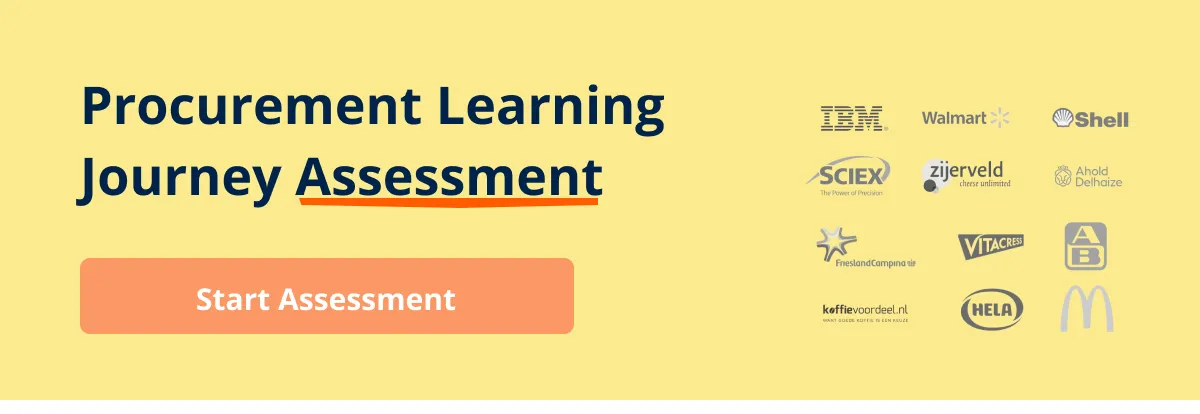Written by Marijn Overvest | Reviewed by Sjoerd Goedhart | Fact Checked by Ruud Emonds | Our editorial policy
RFP Evaluation Criteria — 5 Best Practices
Key takeaways
- RFP evaluation criteria refers to the standards and benchmarks used to evaluate the suitability, availability, and quality of items.
- An RFP is a document that provides contractors with information on the project, its objectives, the organization sponsoring it, the bidding procedure, and the terms of the contract.
- A clear evaluation criteria improve confidence in supplier selection, set expectations, ensure high-quality RFP responses, and promote fairness and transparency.
RFP evaluation criteria best practices are ways you can do to make your RFP process to be efficient, consistent, and transparent. However, what are these best practices?
In this article, we will discuss what RFP means. We will tackle the RFP evaluation criteria and its best practices in the RFP evaluation criteria process.
Once you are done reading this article, you will better understand what RFP evaluation criteria are and why it is important. Additionally, you will be able to use the best practices properly which will streamline your RFP process.
What is RFP?
A request for proposal (RFP) is a document that contains the description of the project and solicits bids from potential contractors to complete it. This document defines the project, goals, and the organization that sponsors it and outlines the bidding process and contract terms.
Also, the RFP is sometimes called a request for procurement as the proposal is about procuring the right materials for a project. It is the procurement phase where the procurement manager puts the details of the project or task to acquire the important materials or services.
RFP is commonly used for head-starting procurement projects and is usually used by governments. Thus, they are familiar with these kinds of procurement requests. It is the job of the procurement manager to assess the bids, the background of the company that wants to bid for the project, and know if the potential companies that bid can undertake the project.
To learn more about the RFP process, click here.
RFP Evaluation Criteria: What is it?
An RFP (Request for Proposal) evaluation criteria are the standards and benchmarks used to assess the quality and suitability of proposals submitted in response to an RFP.
The criteria typically reflect the objectives and needs of the organization issuing the RFP and are used to evaluate the strengths and weaknesses of each proposal.
Having clear evaluation criteria not only improves confidence in supplier selection but also sets expectations, ensures high-quality responses to the RFP, and promotes fairness and transparency in the process.
Additionally, the scoring guidelines help vendors to focus on the key issues and areas of the RFP that are most important to the proposal issuer.
Here are some of the most common RFP evaluation criteria include:
1. Technical expertise
This is the ability of the proposing company or individual to perform the tasks required by the RFP, including experience, qualifications, and knowledge.
2. Costs
This refers to the proposed budget or pricing of the proposal, including any relevant costs such as labor, materials, and equipment.
Of course, if the bid is much higher than the budget, then the company is more likely to not accept that bid.
3. Approach and methodology
This is the proposed approach and methodology for completing the work outlined in the RFP, including timelines, work breakdown structures, and overall project management.
4. Company/Individual qualifications
The proposing company or individual’s past experience, reputation, and financial stability.
You need to check the background of the company if it can commit to the bid it sent to you and if there are no negative reviews regarding its reputation or how it does its work.
5. Compliance
The extent to which the proposal meets all of the requirements and specifications outlined in the RFP.
6. Innovation
This is the extent to which the proposal offers unique and innovative solutions that address the needs and objectives of the organization issuing the RFP.
7. Overall fit
The overall fit of the proposal with the needs and objectives of the organization issuing the RFP, including the ability to deliver the project on time, within budget, and to the required quality standards.
Evaluation Criteria Best Practices
Here are some of the best RFP evaluation criteria best practices:
1. Tell the vendors what you want
Vendors put a lot of effort into creating proposals. Therefore, the more information you provide them about your needs and priorities, the better their responses will be.
It is advisable to include your RFP evaluation criteria and the weighting you plan to use in the RFP document to help them understand your requirements and submit more appropriate proposals.
2. Always stick to your RFP criteria
Once you have established your RFP evaluation criteria, it should be the basis and direction for your scoring process. However, if there are any changes to the criteria, it is important to inform them.
For instance, if you come across a supplier offering services you did not initially consider but now believe are necessary, you should inform all suppliers of this new requirement and allow them to meet it.
This ensures that all suppliers are given a level playing field and helps to avoid any potential risks or compliance issues.
3. Make an RFP Evaluation Guide
The difficulty in evaluating proposals usually arises from uncertainty within the organization regarding scoring expectations. For you to address this, it is advisable to develop a brief guide for stakeholders to follow when evaluating RFPs.
This guide should contain the original list of factors to consider, along with their level of importance. Additionally, if there are subjective questions, it may be helpful to provide further explanations or context to help in the evaluation process.
4. Weight the criteria appropriately
The criteria should be weighted appropriately based on their importance to the project. This ensures that the most critical factors are given the highest weight in the evaluation process.
5. Provide feedback to suppliers
After the evaluation process is completed, it is important to provide feedback to vendors to help them understand why their proposal was or was not selected.
This helps to build better relationships with suppliers and improve the quality of future proposals.
Conclusion
A request for proposal for RFP is a document that contains the description of the project and solicits bids from potential contractors to complete it. In addition, it also defines the project, goals, and the organization that sponsors it and outlines the bidding process and contract terms.
Moreover, RFP is also commonly used for head-starting procurement projects and is usually used by governments and government agencies.
Furthermore, an RFP needs evaluation criteria that define the standards and benchmarks used to assess the quality and suitability of proposals submitted in response to an RFP. With that, before issuing an RFP, you should be able to tell the sellers what you want, make an RFP evaluation guide, and stick to it.
Frequentlyasked questions
What is RFP?
It is a document that contains the description of the project and solicits bids from potential contractors to complete it.
What are the RFP evaluation criteria?
These are the standards and benchmarks used to assess the quality and suitability of proposals submitted in response to an RFP.
Why is it important to have clear and objective evaluation criteria?
Clear and objective evaluation criteria help to standardize the evaluation process and remove subjectivity. Thus, it leads to a fair and transparent process.
About the author
My name is Marijn Overvest, I’m the founder of Procurement Tactics. I have a deep passion for procurement, and I’ve upskilled over 200 procurement teams from all over the world. When I’m not working, I love running and cycling.


